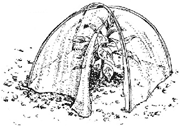|
|||||||||||
|
|||||||||||
April’s Cold May Mean Less FruitBut most spring-blooming flowers should be safeIt is highly unlikely that we will be harvesting apricots and cherries from our gardens this year. Matter of fact, the Bay Gardener lost more that half of his crop of peaches this year. The nectarines survived much better because more than half of their flowers were still tightly curled when the frost came. Freezing temperatures will kill most open flowers. On fruit trees, the last frosts killed most flowers that were open or opening. Flower buds that were still tightly closed remained unaffected. As soon as a flower bud begins to uncurl petals, it loses its resistance to freezing temperatures. Flower buds of peach trees tightly closed during those frosty mornings were capable of tolerating temperatures into the low 20s. However, those flower buds that were beginning to open or were already open were killed when temperatures dropped to freezing. Apricots and cherries are the first to flower and fruit. They were killed instantly by the first frost because nearly all of their flowers were fully open. It is safe to say that flowers of azaleas, rhododendrons, mountain laurel and lilac were still tightly closed and perfectly cold hardy. What is interesting is to closely examine the flowers of forsythia. You will notice that only the margins of the petals appear to have brownish tissue. The remaining parts of the flower are perfectly healthy. It is one of the few species with cold-hardy flowers. Magnolia flowers that were open during those cold mornings have all turned brown and dropped. Now that many of the trees and shrubs have started producing new growth at the tips of the branches, a late frost now would certainly kill that new growth. Should a frost occur, new growth would start further down the branch but would be considerably delayed because those buds are slower to develop. The tips of the branches where the new growth was killed would turn brown and dry up. The most effective method of protecting plants from frost damage is to cover them with plastic, cloth or even paper. Before covering them, spray their branches and foliage thoroughly with water. Wet the plastic, cloth or paper to provide additional protection in two ways: one by minimizing the evaporation of water from the plant tissues; and two, by adding the insulating value of water. If you hear of a frost warning after you have planted your tomatoes, peppers and annual flowers, cover them with sheets of plastic or blankets to trap the ground heat. Commercial growers use floating covers — a white non-woven fabric like house wrap — to protect crops from frost damage. To protect individual plants, invert a pot or basket over each. Avoid using metal containers because metal is not a good insulator. Ask Dr. Gouin your questions at [email protected]. All questions will appear in Bay Weekly. Please include your name and address. |
|||||||||||
|
|||||||||||
|
|
|||||||||||
|
© COPYRIGHT 2007 by New Bay Enterprises, Inc. All rights reserved.
|
|||||||||||


